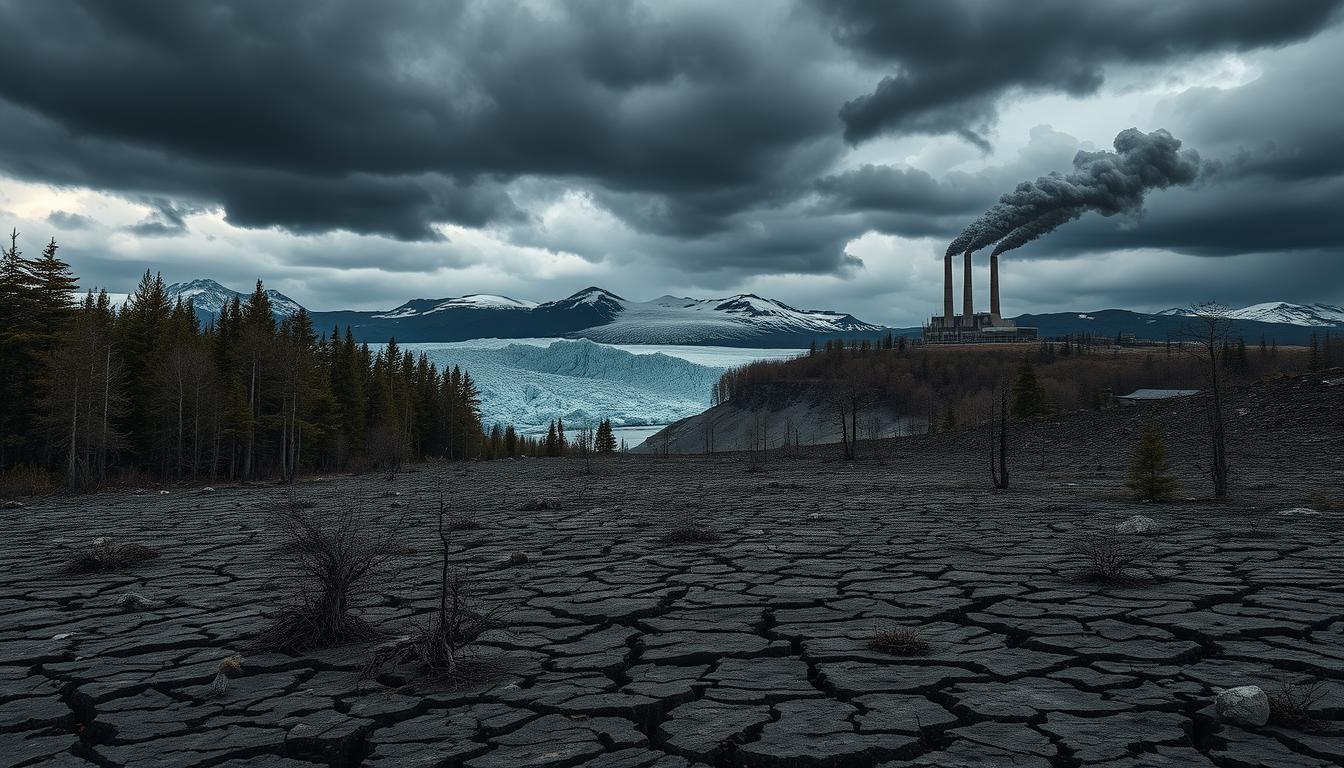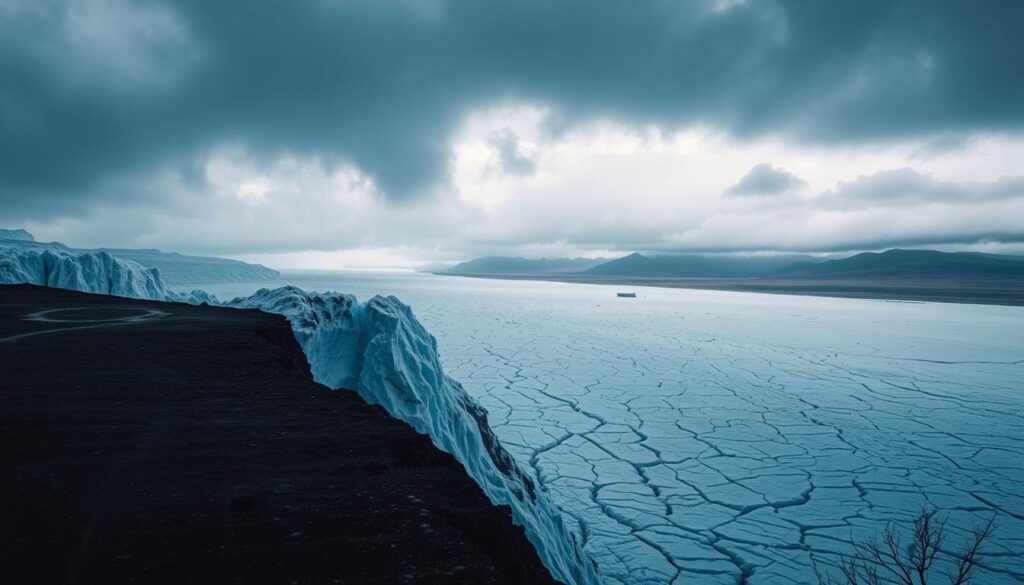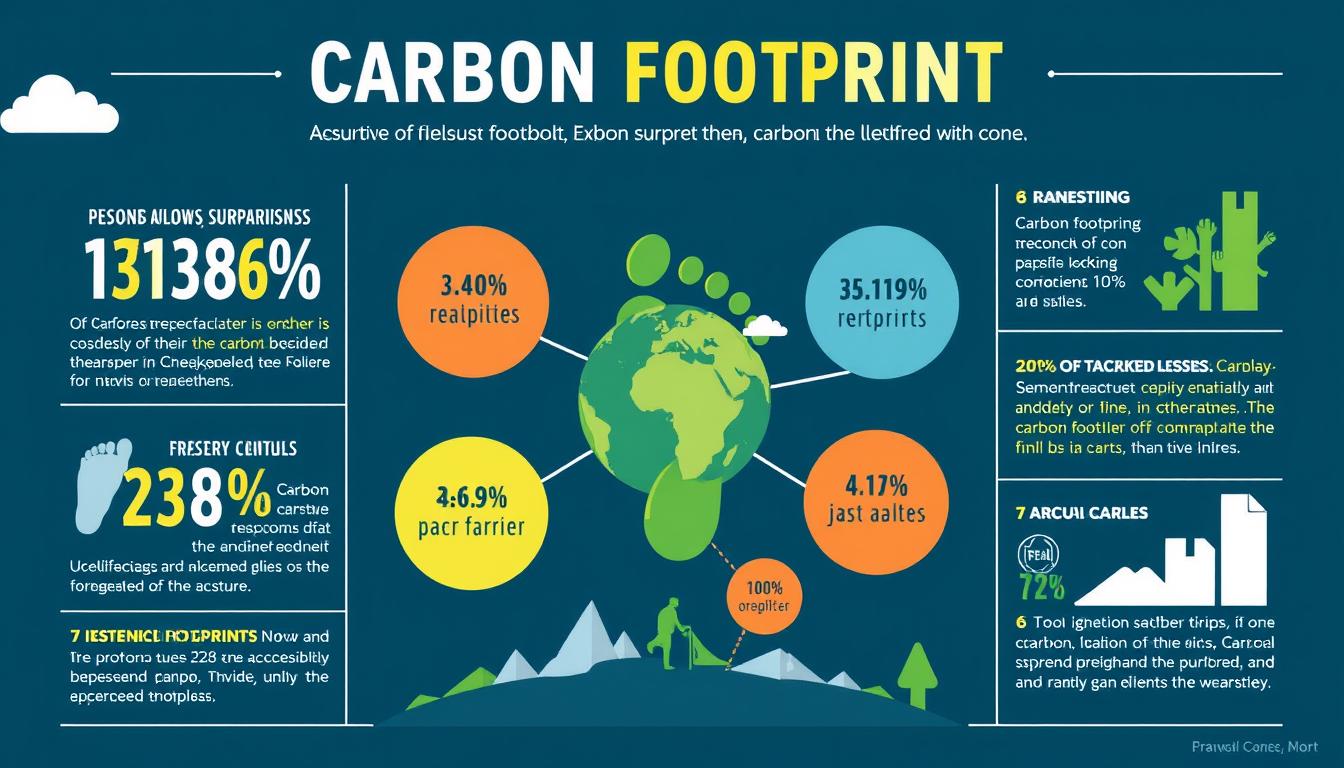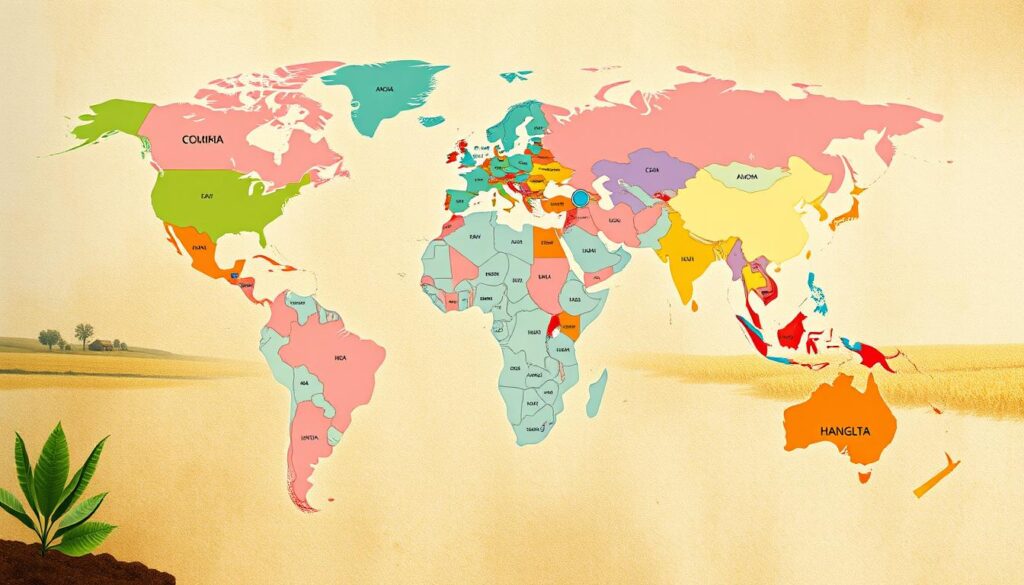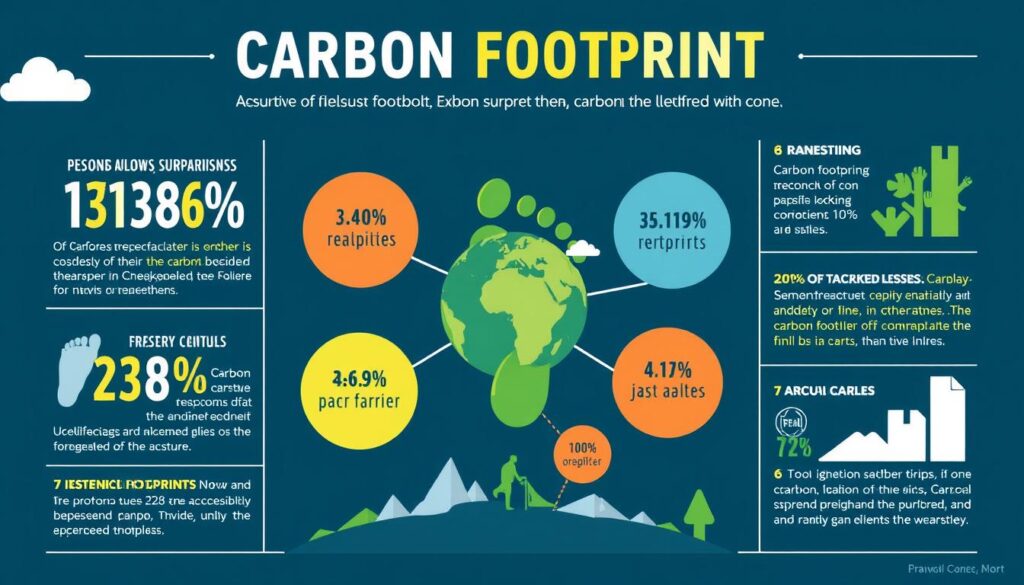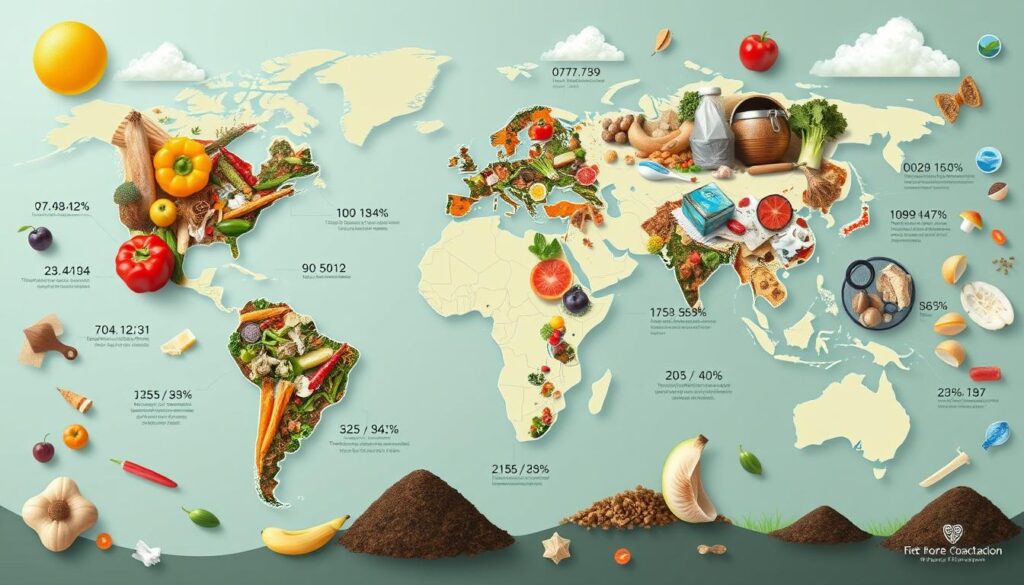Did you know our planet is warmer now than it has been in 800,000 years? This fact is just the start of some scary news about the climate crisis changing our world. The latest research shows how urgent our situation is.
Global warming is not just setting records; it’s breaking them. By 2011-2020, the world’s temperature had risen 1.1 degrees Celsius from 1850-1900 levels. There’s a 50% chance we’ll hit 1.5 degrees in the next decade. This small rise could lead to huge problems, like a huge increase in wildfires and sea levels rising by 0.3 meters.
The summer of 2023 was the hottest on record globally, beating 2016’s intense heat. This isn’t just about bad weather; it shows climate change is getting worse. Greenhouse gas levels have never been higher, with carbon emissions from fossil fuels and industry reaching 36.8 billion metric tons in 2022.
The impact of climate change goes beyond just rising temperatures. Over half of the world’s coral reefs have died in 30 years, and two-thirds of the Great Barrier Reef have suffered damage from coral bleaching. Even more alarming, up to 50% of Earth’s species could vanish by mid-century due to the current extinction rate, which is 1,000 times the natural rate.
These changes aren’t just affecting nature; they’re changing human society too. Climate change is causing a refugee crisis, with estimates suggesting up to 200 million people could be displaced by 2050. It shows that global warming’s effects are much bigger than just melting ice caps and rising seas.
Key Takeaways
- Earth is warmer now than in the last 800,000 years
- Global temperatures could surpass 1.5°C above pre-industrial levels within a decade
- Summer 2023 was the hottest on record globally
- Greenhouse gas emissions are at an all-time high
- Over half of the world’s coral reefs have died in 30 years
- Up to 200 million climate refugees expected by 2050
- Current extinction rate is 1,000 times the natural rate
Table of Contents
- 1 The 2030 Climate Change Point of No Return
- 2 Record-Breaking Global Temperatures in 2023
- 3 Unprecedented Greenhouse Gas Emission Levels at an All-Time High
- 4 Melting Glaciers Add 24,000 Tons of Water to the Oceans Each Second
- 5 Mass Extinction Crisis: One Million Species at Risk
- 6 Climate Change Induced Human Migration
- 7 Ocean Ecosystems in Critical Danger
- 8 Earth’s Resource Depletion Crisis
- 9 Devastating Impact on Global Food Security
- 10 Extreme Weather Events Intensification
- 11 Over 90% of people breathe unhealthy levels of air pollution
- 12 Human Health Threats from Climate Change
- 13 Global Economic Impact Projections
- 14 Climate Change Effect on Seasonal Patterns
- 15 Current International Climate Action Status
- 16 Source Links
The 2030 Climate Change Point of No Return
The world is at a critical point in the fight against climate change. As we near 2030, scientists warn of a climate tipping point. This could cause irreversible damage. The UN Intergovernmental Panel on Climate Change (IPCC) report shows a dire future if we don’t act fast.
UN Intergovernmental Panel Warnings
The IPCC report paints a clear picture: global warming will likely exceed 1.5 degrees Celsius by 2030. This is true, no matter our emissions choices. We’re getting close to a climate tipping point, with severe consequences for our planet.
Predicted Environmental Catastrophes
As we near the 1.5 degrees Celsius mark, we face environmental disasters. Coral reefs, key marine ecosystems, are at risk of being wiped out. Extreme weather, like floods, droughts, and wildfires, will become more common and intense.
Economic Impact Forecasts
The economic effects of hitting this climate tipping point are dire. Coastal areas face sea level rise threats, while farms struggle with changing weather. These changes could lead to widespread poverty and economic trouble.
| Temperature Increase | Projected Impact |
|---|---|
| 1.5°C | 70-90% coral reef loss |
| 2°C | 99% coral reef loss |
| 1.5°C | 0.3m sea level rise |
| 2°C | 0.4m sea level rise |
While hitting 1.5 degrees Celsius seems unlikely, every small degree matters in fighting climate change. We need bold goals and long-term plans to tackle this crisis.
Record-Breaking Global Temperatures in 2023
In 2023, the world saw record-breaking heatwaves and temperature records. It was the hottest year in at least 173 years, with temperatures 1.48°C (2.66°F) above pre-industrial levels. This led to more extreme weather events around the globe.
Climate anomalies became the norm. Sea surface temperatures hit new highs. Phoenix, Arizona, faced its hottest month ever, with 31 days over 110°F.
The effects were severe. Maricopa County, where Phoenix is, saw at least 579 heat-related deaths. This shows we need to act fast to protect human health and safety from global warming.
The climate crisis wasn’t just about heat. Canada had its worst wildfire season ever. The burned area was as big as North Dakota, affecting air quality in Europe. These events show how climate change affects ecosystems and air quality.
| Climate Event | Impact |
|---|---|
| Global Temperature Rise | 1.48°C above pre-industrial levels |
| Phoenix Heatwave | 31 days above 110°F |
| Canadian Wildfires | Area burned equivalent to North Dakota |
These climate events remind us of the urgent need to meet the 1.5°C Paris Agreement goal. To avoid more warming, we must cut greenhouse gas emissions by 43% by 2030. We must act now to protect our planet’s future.
Unprecedented Greenhouse Gas Emission Levels at an All-Time High
Greenhouse gas emissions have hit record highs, putting our planet at risk of climate disaster. In 2023, emissions hit 57.4 gigatonnes, the highest ever. This rise in CO2 levels threatens our environment and future.
Carbon Dioxide Concentration Records
Our atmosphere now holds more carbon dioxide than ever before. CO2 levels are 50% higher than before humans started burning fossil fuels. In 2023, they reached 419 parts per million (ppm). This sharp increase is due to fossil fuel burning and human activities.
Industrial Contribution to Emissions
Industries are a big part of the problem with fossil fuel emissions. The industrial sector’s carbon footprint keeps growing. We need to cut emissions by 43% by 2030 to avoid severe warming.
Transportation Sector Impact
The transportation sector is also a major contributor to emissions. With more global trade and car use, emissions have soared. Switching to electric vehicles and improving public transport is key to reducing emissions.
If we keep going, we face a 2.5-2.9°C rise in global temperatures. This shows how urgent it is for us to act together to lower emissions and fight climate change.
Melting Glaciers Add 24,000 Tons of Water to the Oceans Each Second
I’m seeing something amazing: every second, 24,000 tons of water from melting glaciers flow into our oceans. This is making sea levels rise at a fast 3 millimeters per year. The effects of this are huge, harming coastal areas and wildlife homes.
Coastal Community Impacts
Sea levels have gone up over 8 inches from 1880, with a big jump in the last 25 years. This fast rise in sea levels is causing erosion and putting the lives of millions at risk. The Aru Glacier in western Tibet is a clear example of the dangers of unstable glaciers. In 2016, it grew 75 meters and then collapsed, covering nearly 10 square kilometers in minutes, killing 9 people.
Wildlife Habitat Loss
The fast melting of glaciers is changing ecosystems. Temperatures in glacier areas like western Tibet have risen by 1.5°C in 50 years, making wildlife habitats disappear. Forests, which cover over 30% of Earth, are also at risk. We’ve lost 1.3 million square kilometers of forest in the last 25 years, making habitat loss worse.
| Impact | Statistic |
|---|---|
| Ocean Water Addition | 24,000 tons/second |
| Sea Level Rise | 3 mm/year |
| Total Sea Level Increase (from 1880) | Over 8 inches |
| Forest Loss (last 25 years) | 1.3 million sq km |
Mass Extinction Crisis: One Million Species at Risk
The Earth is facing a huge loss of biodiversity, with over one million species at risk of extinction in the next decades. This crisis shows how urgent it is to stop ecosystem collapse and species extinction. Most threatened species, 99%, are harmed by human actions like habitat destruction and global warming.
The crisis is massive. Between 1980 and 2000, we lost 100 million hectares of tropical forest. By 2000, only 13% of wetlands from 1700 remained. These losses harm wildlife greatly. The biomass of wild mammals has dropped by 82%, and 25% of animals and plants are threatened.
Climate change makes things worse. A 2°C temperature rise could risk 5% of species. If temperatures increase by 4.3°C, 16% of species could face extinction. The balance of our ecosystems is at risk, with severe consequences.
| Species Group | Extinction Risk |
|---|---|
| Primates | Almost 50% |
| Freshwater Fish (North America) | At least 39% |
| Invertebrates | About 30% |
| Plants | Approximately 68% |
This extinction crisis affects more than just wildlife. It impacts water quality, food security, and natural pest control. We must act now to protect biodiversity and fight climate change.
Climate Change Induced Human Migration
Climate change is changing our world, making people leave their homes. This crisis of climate refugees and environmental migration is a big global problem.
Displacement Statistics and Projections
The number of people displaced by climate change is huge. Millions of Americans will move in the next decades to avoid climate disasters like wildfires and rising seas. Worldwide, the situation is even worse. Up to 75% of the world’s population could face deadly heat and humidity by 2100.
Most Vulnerable Populations
Some groups are hit harder by climate change. Young people in poor countries will face more climate dangers than those in rich countries as temperatures rise. In the US, areas like the southwest and Gulf Coast are getting less habitable.
Economic Refugees from Environmental Disasters
The economic effects of climate migration are big. Between 1970 and 2019, disasters caused over two million deaths and $4.3 trillion in losses. Businesses are getting ready for growth in areas welcoming climate migrants.
| Climate Change Impact | Current Status | Future Projection |
|---|---|---|
| Global Temperature Increase | 1.1°C above pre-industrial levels | Up to 2.7°C increase possible |
| Population Living in Extreme Heat | 9% of global population | Up to 33% of global population |
| Extreme Weather Events | 5x increase in 1970 | Further intensification expected |
Ocean Ecosystems in Critical Danger
I’ve found some scary facts about our oceans. Did you know oceans cover 70 percent of Earth and hold 97 percent of all water? That’s a huge 1.3 billion cubic kilometres. But these vast waters are facing big problems.
Ocean acidification has gone up by nearly 30 percent because of industrial activities. This change is happening fast, harming marine life in new ways. Coral reefs, which are home to 25 percent of marine species, are very vulnerable.
Climate change is making marine species move faster than land animals. It’s also damaging important places like seagrass beds and kelp forests. The damage to coral bleaching could cost up to $12 billion a year in lost tourism.
The situation is very bad. By 2050, almost all coral reefs might struggle to grow because of acidity. This could harm ocean ecosystems and human health, as fisheries provide 20 percent of animal protein for 3 billion people.
We’re at a critical point for marine life. The earth is losing about 1.2 trillion tons of ice yearly, making ocean ecosystems unstable. It’s clear we need to act fast to save our oceans and the life they support.
Earth’s Resource Depletion Crisis
Our planet is facing a severe crisis due to resource depletion. The concept of Earth Overshoot Day shows how fast we’re using up resources. This day marks when our demand for resources goes beyond what Earth can replace in a year.
Overshoot Day Analysis
Earth Overshoot Day comes earlier each year, showing our growing ecological footprint. In 2023, global temperatures hit 1.46°C above pre-industrial levels. Carbon dioxide levels also reached over 420 ppm. These numbers highlight the need for sustainable practices.
Resource Consumption Rates
Half of global greenhouse gas emissions come from extracting and processing materials, fuels, and food. This also causes over 90% of biodiversity loss and water stress. Material extraction has tripled, with a fivefold increase in non-metallic minerals and a 45% rise in fossil fuel use.
Sustainability Thresholds
We’d need 1.7 Earths to meet our current demand on ecosystems. By 2060, material use could double to 190 billion tonnes. Greenhouse gas emissions might also rise by 43%. These projections show we must tackle overconsumption and push for sustainable development.
| Resource | Current Status | Future Projection |
|---|---|---|
| Forests | 300 football fields cut down hourly | Only 10% may remain by 2030 |
| Plastic Production | 419 million tons in 2015 | 29 million tons entering oceans yearly by 2040 |
| Food Waste | 1.3 billion tons wasted annually | Accounts for 25% of global greenhouse gas emissions |
To tackle this crisis, we must adopt sustainable practices and lessen our ecological footprint. As I learned from sustainable food practices, small daily changes can lead to a greener future.
Devastating Impact on Global Food Security
Climate change is a big threat to food security worldwide. Rising temperatures and extreme weather events are causing huge problems in farming. In the Horn of Africa, 31.1 million people are struggling to find food, and in Southern Africa, 39 million are hungry because of drought.
Crop failures are happening more often, making food prices go up. In Malawi, maize prices jumped 192% in July. This makes basic foods too expensive for many, worsening food shortages. In Ethiopia, 9.7 million people need emergency food aid.
The effects of climate change on farming are huge. Farming is responsible for 26% of global greenhouse gas emissions and uses half of the world’s land. This creates a cycle where farming suffers from and adds to climate change. Livestock farming, in particular, has a big environmental impact, making up 94% of non-human mammal biomass.
We need to act fast to solve these problems. Early action in droughts saves 40% compared to waiting. By investing in farming practices that can handle climate change, we can lessen its effects on food. This includes supporting local farming, which could provide 95% of coarse grains in sub-Saharan Africa by 2030.
The quality of our food is just as important as having enough. As we face these global issues, we must make sure our food is not only plentiful but also healthy and sustainable for everyone and the planet.
Extreme Weather Events Intensification
Climate change is making natural disasters worse, leading to more frequent and severe weather events. I’ve seen a disturbing trend in extreme weather patterns. It’s changing how we view natural disasters.
Hurricane Frequency Increase
Hurricanes are getting more destructive because of warmer ocean temperatures. These storms are now 25% more likely to become major hurricanes than 40 years ago. The changes are concerning. Hurricanes near the US are slowing down by about 17%, which increases the risk of flooding.
Wildfire Devastation Records
Wildfires are causing unprecedented destruction. In 2020, California wildfires burned over 4 million acres, an area bigger than Connecticut. The 2018 Camp Fire, California’s deadliest wildfire, destroyed a football field worth of land every three seconds and claimed 68 lives. These events show the growing threat of extreme weather to communities and ecosystems.
Flood Pattern Changes
Flooding incidents are increasing, causing widespread damage. In July 2023, heavy rainfall and flash flooding in the Northeast caused significant damages and at least one fatality. The number of climate-related disasters has tripled in the last 30 years, with floods forcing millions from their homes. In South Asia alone, floods and landslides displaced 12 million people in India, Nepal, and Bangladesh over the past year.
| Extreme Weather Event | Impact | Region |
|---|---|---|
| Hurricanes | 25% more likely to reach major status | Global |
| Wildfires | 4 million acres burned (2020) | California |
| Floods | 12 million people displaced | South Asia |
These extreme weather events show we need to act fast on climate change. We must develop strategies to protect vulnerable communities worldwide.
Over 90% of people breathe unhealthy levels of air pollution
I’m shocked to report that 99% of the global population breathe air exceeding WHO guideline limits, containing dangerous levels of pollutants. This fact shows a huge crisis in air quality affecting billions. The harm to respiratory health is severe, with smog and particulate matter causing big problems.
In urban areas, the situation is dire. London faces around 4,000 premature deaths annually due to air pollution, while the UK sees 43,000 such deaths. Children growing up in polluted environments may suffer a 5% reduction in lung capacity. This shows the long-term effects of poor air quality.
The economic toll is staggering. Recent studies suggest that the damage caused by air pollution to human health is approximately twice as bad as previously estimated. This highlights the urgent need for action to improve air quality and protect public health.
| Region | Annual Premature Deaths |
|---|---|
| London | 4,000 |
| UK | 43,000 |
| Global | 4.2 million |
To combat this crisis, we must prioritize clean energy transitions and reduce traffic levels. A 20% decrease in car miles by 2030 is deemed necessary to cut emissions effectively. By addressing air pollution, we can significantly improve respiratory health and save millions of lives worldwide.
Human Health Threats from Climate Change
Climate change is a big threat to human health. I’ve seen how rising temperatures hurt communities in the United States. Heat-related illnesses are getting worse, hitting cities hard.
The elderly and those with health issues are most at risk. They can’t handle the heat as well.
Vector-borne diseases are also a big worry. Warmer temperatures let ticks and mosquitoes spread further. This has led to more cases of Lyme disease and other illnesses in new areas.
The mental health effects of climate change are serious too. A study showed 60 percent of young people aged 16-25 are very worried about climate change. This worry affects their daily lives, impacting their ability to function.
Extreme weather events cause spikes in PTSD, depression, and sleep problems.
Our healthcare systems are feeling the strain. By 2100, many areas will face multiple climate disasters at once. This will affect 27 different health aspects. From heat stress to water-borne illnesses, the challenges are vast and complex.
It’s clear we must tackle climate change to protect public health.
Global Economic Impact Projections
Climate change is changing our economy. The U.S. could lose $520 billion a year by 2100 if temperatures rise by 4.5˚C. This shows how urgent it is to tackle climate change and its economic effects.
Agriculture, a key part of the U.S. economy, will face big losses. The Midwest, known as America’s breadbasket, could see corn and soybean yields drop by up to 25% by 2050. This could harm food security and jobs in rural areas, making farming practices need to adapt.
Extreme weather events are causing huge economic losses. North America has lost $415 billion in just three years due to climate disasters, with hurricanes and wildfires being major causes. These events destroy things right away and also disrupt the economy for a long time, affecting buildings, businesses, and communities.
The job market will also be hit hard by climate change. By 2090, the U.S. could lose two billion labor hours a year, costing $160 billion in lost wages. This means less work and fewer jobs in areas that are vulnerable to climate change, making it important to adapt and diversify the economy.
Worldwide, climate change’s economic effects will mostly be bad by the end of this century, with poor countries hit the hardest. This shows we need to work together to fight climate change and help countries that are most vulnerable.
Looking at these big challenges, it’s clear that spending on climate change adaptation and prevention is not just good for the planet. It’s also essential for the economy. Not acting now will cost much more than the investment needed for a strong, sustainable economy.
Climate Change Effect on Seasonal Patterns
Climate change is changing our world, making seasons shift. I’ve seen falls, winters, and springs get shorter while summers get longer. This change is big in North America, where winters are losing their snow, hurting ski spots.
These changes affect more than just our fun. Ecosystems are getting disrupted, and species are having trouble adapting. They’re finding it hard to keep up with the new seasons.
In Ireland, the average temperature has gone up by 0.8°C from 1900. It’s expected to rise another 1–1.6℃ by mid-century. This warming is changing how much rain Ireland gets, with a 5% increase in rainfall over the past few decades.
Worldwide, the Earth has warmed by about 1°C because of us. This warming is causing big changes in ecosystems, like the melting Arctic and the stressed Amazon rainforest.
These changes affect us every day. They change what we grow and how much energy we use. For example, buildings use a lot of electricity, which adds to greenhouse gases. As seasons change, so will our energy needs.
Even though it seems tough, there’s hope. Making small changes at home, like using less energy or throwing away less food, can help. Even choosing what we drink can make a difference. For example, picking healthier drinks can be a step towards a greener life.
| Climate Change Impact | Global | Ireland |
|---|---|---|
| Temperature Increase | 1°C from Industrial Revolution | 0.8°C from 1900 |
| Projected Temperature Increase | 1.5°C by 2030-2052 | 1-1.6°C by mid-century |
| Sea Level Rise | 3.6 mm per year (2006-2015) | 0.6°C per decade from 1994 |
Current International Climate Action Status
The Paris Agreement was a big step forward in fighting climate change. But, progress is moving too slowly. No major country is on track to meet the 1.5°C goal, seven years after the agreement started. The Earth is now 1.2°C warmer than before, with 2023 being the hottest year, at 1.45°C above the baseline.
Emissions targets are not being met. In 2023, greenhouse gas emissions reached a record high of 57.4 gigatonnes. To avoid a 1.5°C rise, we need a 43% cut by 2030. The Climate Change Performance Index shows Nordic countries leading in green energy and cutting emissions.
Working together is key. The Intergovernmental Panel on Climate Change has 195 member countries and 234 authors from 66 countries. Despite this, many countries missed the July 31 deadline to update their climate plans. Climate education is missing from most countries’ plans, showing a big gap in action.
Source Links
- Six scary facts about climate change – Ecotricity – https://www.ecotricity.co.uk/our-news/2017/six-scary-facts-about-climate-change
- 5 Climate Change Facts to Scare You Into Action This Halloween – Earth Day – https://www.earthday.org/5-terrifying-climate-change-facts-scare-halloween/
- Many scientists don’t want to tell the truth about climate change. Here’s why – https://www.wbur.org/cognoscenti/2023/10/03/1-5-degrees-celcius-un-climate-change-report-barbara-moran
- 2023 was the hottest year on record. It also pushed the world over a dangerous line. – https://www.vox.com/23969523/climate-change-cop28-paris-1-5-c-uae-2023-record-warm
- The year’s most extreme weather shows what a warming planet is capable of, and what’s to come | CNN – https://www.cnn.com/2023/12/30/weather/extreme-weather-climate-change-2023/index.html
- Key Findings | United Nations – https://www.un.org/en/climatechange/science/key-findings
- OBSERVER: 2023 – A year of unprecedented heat and climate extremes – http://www.copernicus.eu/en/news/news/observer-2023-year-unprecedented-heat-and-climate-extremes
- Anya Anti Art — 2.5 seconds – https://anya-anti.com/25-seconds
- So Here’s Another Thing Global Warming Causes: Catastrophic Glacial Avalanches – https://www.syfy.com/syfy-wire/so-heres-another-thing-global-warming-causes-catastrophic-glacial-avalanches
- Halting the Extinction Crisis – https://www.biologicaldiversity.org/programs/biodiversity/elements_of_biodiversity/extinction_crisis/index.html
- Nature crisis: Humans ‘threaten 1m species with extinction’ – https://www.bbc.com/news/science-environment-48169783
- How climate-driven migration could change the face of the U.S. – https://www.npr.org/2024/03/26/1239904742/how-climate-driven-migration-could-change-the-face-of-the-u-s
- In-depth Q&A: How does climate change drive human migration? – https://interactive.carbonbrief.org/climate-migration/index.html
- Climate Change Poses a Threat to Our Oceans | United Nations – https://www.un.org/en/chronicle/article/climate-change-poses-threat-our-oceans
- Fifth National Climate Assessment, Chapter 10: Ocean Ecosystems and Marine Resources – https://nca2023.globalchange.gov/chapter/10
- The Biggest Environmental Problems Of 2021 – https://earth.org/the-biggest-environmental-problems-of-our-lifetime/
- We’re gobbling up the Earth’s resources at an unsustainable rate – https://www.unep.org/news-and-stories/story/were-gobbling-earths-resources-unsustainable-rate
- 5 things you need to know about climate change and hunger | Oxfam International – https://www.oxfam.org/en/5-things-you-need-know-about-climate-change-and-hunger
- Environmental Impacts of Food Production – https://ourworldindata.org/environmental-impacts-of-food
- How climate change is rewriting the rules of extreme storms – https://www.bbc.com/future/article/20240712-modern-hurricanes-are-rewriting-the-rules-of-extreme-storms
- How Climate Change Is Fueling Extreme Weather – https://earthjustice.org/feature/how-climate-change-is-fueling-extreme-weather
- 5 natural disasters that beg for climate action | Oxfam International – https://www.oxfam.org/en/5-natural-disasters-beg-climate-action
- How air pollution is destroying our health – https://www.who.int/news-room/spotlight/how-air-pollution-is-destroying-our-health
- 20 shocking facts about air pollution | Friends of the Earth – https://friendsoftheearth.uk/climate/20-shocking-facts-about-air-pollution
- Volts podcast: David Wallace-Wells on air pollution – https://www.volts.wtf/p/volts-podcast-david-wallace-wells
- Climate Anxiety – https://magazine.hms.harvard.edu/articles/climate-anxiety
- Think this was a bad year for climate disasters? Just wait – https://www.nbcnews.com/health/health-news/climate-change-going-make-life-earth-whole-lot-worse-report-n938101
- How Climate Change Impacts the Economy – https://news.climate.columbia.edu/2019/06/20/climate-change-economy-impacts/
- The Economic Effects of Climate Change – https://www.aeaweb.org/articles?id=10.1257/jep.23.2.29
- What impact will climate change have on Ireland? – https://www.epa.ie/environment-and-you/climate-change/what-impact-will-climate-change-have-for-ireland/
- What is climate change: facts for kids | National Geographic Kids – https://www.natgeokids.com/uk/discover/geography/general-geography/what-is-climate-change/
- Causes and Effects of Climate Change | United Nations – https://www.un.org/en/climatechange/science/causes-effects-climate-change
- Climate Change in 2024: Where Do We Stand? – https://greenly.earth/en-us/blog/ecology-news/climate-change-in-2022-where-do-we-stand
